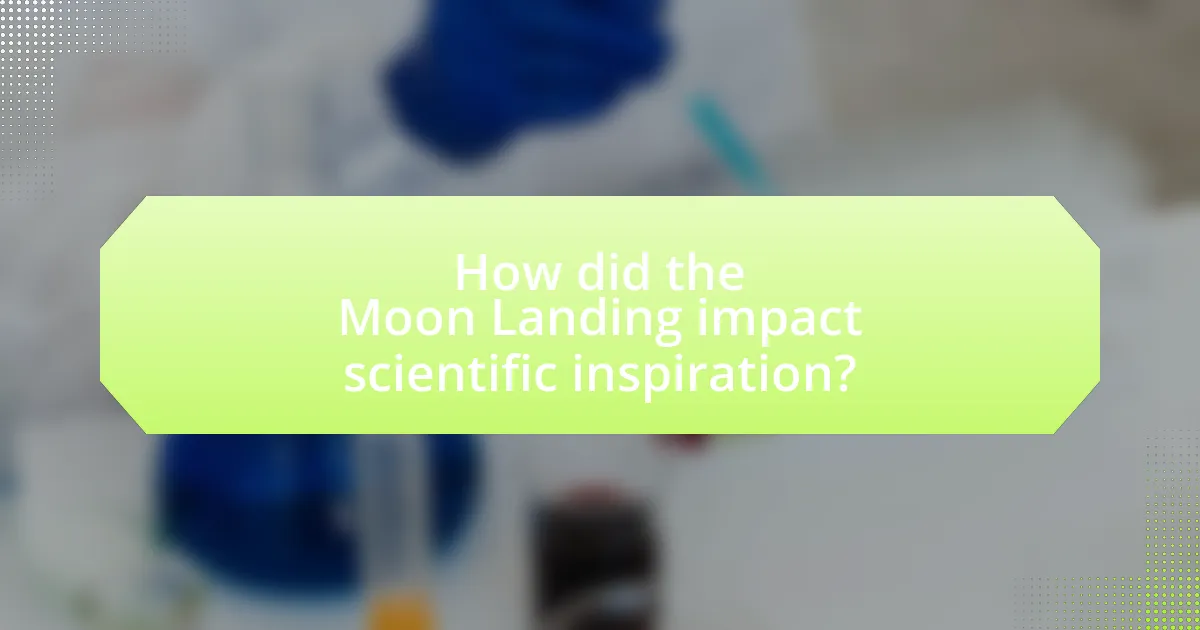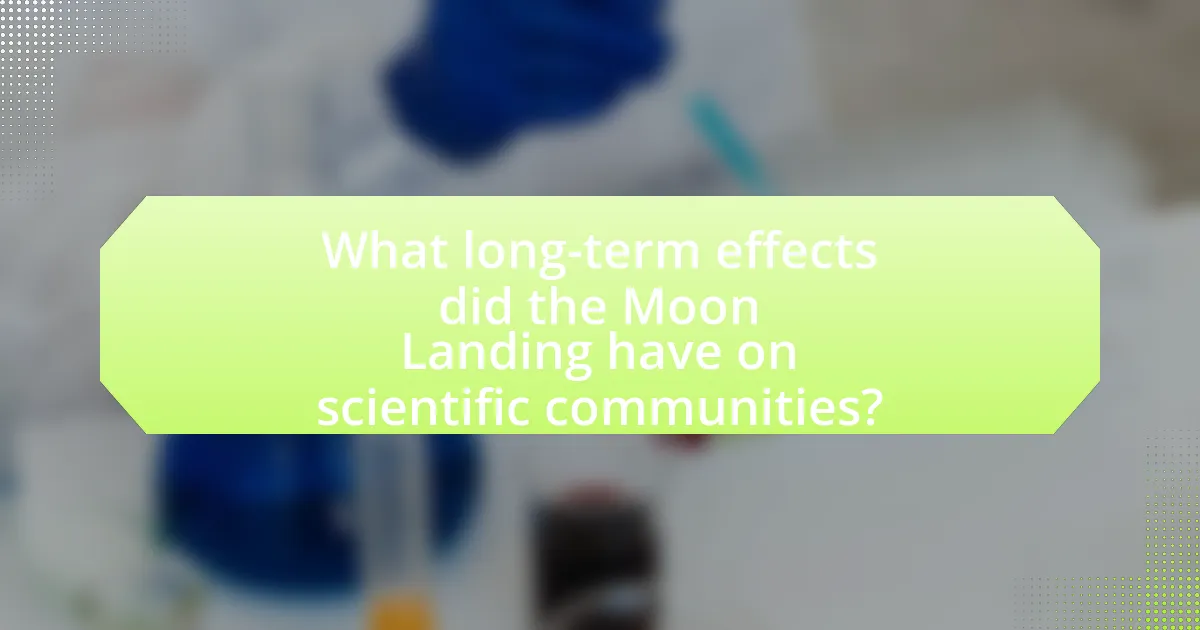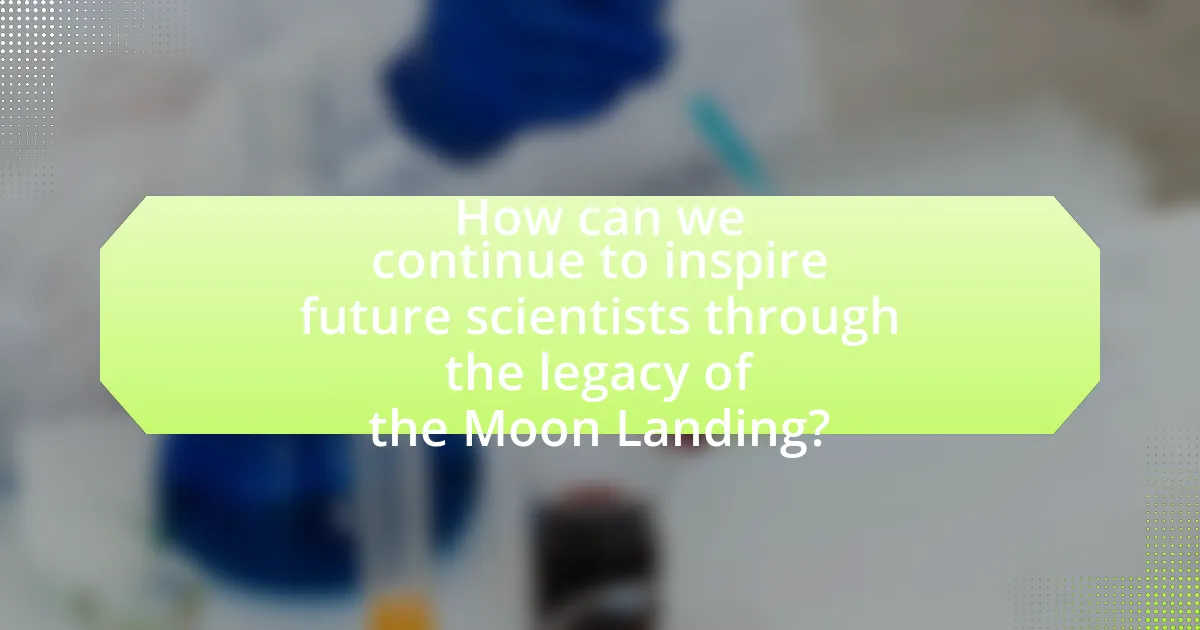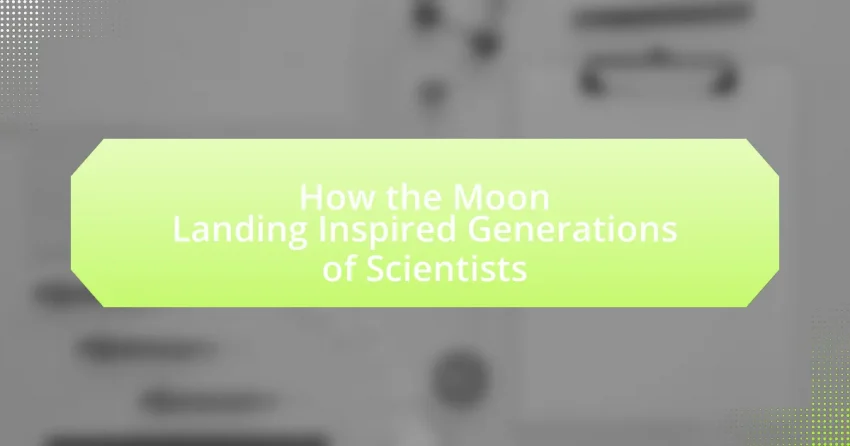The Moon Landing, achieved by Apollo 11 in 1969, significantly inspired generations of scientists by showcasing human ingenuity and the potential for exploration. This historic event led to increased interest in STEM fields, resulting in a notable rise in degrees awarded in science and engineering. The Moon Landing catalyzed advancements in various scientific disciplines, boosted funding for space exploration, and fostered a culture of innovation that continues to influence technology and education today. Furthermore, it inspired numerous initiatives aimed at promoting interest in space science and shaped educational programs to engage future scientists. The legacy of the Moon Landing remains evident in ongoing projects and the continued pursuit of knowledge in space exploration.

How did the Moon Landing impact scientific inspiration?
The Moon Landing significantly impacted scientific inspiration by demonstrating the possibilities of human ingenuity and exploration. This monumental achievement in 1969, when Apollo 11 successfully landed astronauts on the lunar surface, ignited interest in STEM fields, leading to increased enrollment in science and engineering programs. According to a study by the National Science Foundation, the Apollo program inspired a generation of scientists and engineers, resulting in a 20% increase in degrees awarded in physical sciences and engineering in the years following the landing. The success of the Moon Landing also fostered a culture of innovation, encouraging research in various fields such as materials science, robotics, and telecommunications, which have had lasting effects on technology and scientific inquiry.
What were the immediate effects of the Moon Landing on scientific fields?
The immediate effects of the Moon Landing on scientific fields included a significant boost in funding and interest in space exploration, as well as advancements in various scientific disciplines such as materials science, engineering, and planetary science. Following the Apollo 11 mission in 1969, NASA’s budget increased substantially, leading to the development of new technologies and methodologies. For instance, the need for lightweight materials for spacecraft resulted in innovations like improved alloys and composites, which have since been applied in industries beyond aerospace. Additionally, the Moon Landing spurred research in planetary geology, as scientists began to study lunar samples returned to Earth, enhancing our understanding of the Moon’s composition and formation. This influx of resources and focus on interdisciplinary collaboration laid the groundwork for future scientific endeavors, including Mars exploration and satellite technology.
How did the Moon Landing influence space exploration research?
The Moon Landing significantly advanced space exploration research by demonstrating the feasibility of human space travel and the potential for scientific discovery beyond Earth. This historic event, achieved on July 20, 1969, during NASA’s Apollo 11 mission, provided critical data on lunar geology, which informed subsequent missions and research initiatives. The success of the Moon Landing led to increased funding and interest in space programs globally, resulting in the establishment of international collaborations, such as the International Space Station, and spurred technological innovations in spacecraft design, materials science, and robotics. Furthermore, the Moon Landing inspired a generation of scientists and engineers, leading to a surge in STEM education and careers focused on space exploration, as evidenced by the significant increase in university programs related to aerospace engineering and planetary science following the Apollo missions.
What role did the Moon Landing play in advancing technology and engineering?
The Moon Landing significantly advanced technology and engineering by driving innovations in various fields, including materials science, telecommunications, and computer technology. The Apollo program necessitated the development of lightweight materials, such as aluminum alloys and advanced composites, which are now widely used in aerospace and automotive industries. Additionally, the mission led to breakthroughs in telecommunications, exemplified by the creation of miniaturized electronics and satellite technology, which have become integral to modern communication systems. The rigorous demands of the Moon Landing also spurred advancements in computer technology, including the development of real-time computing and software engineering practices, which laid the groundwork for contemporary computing systems. These advancements are evidenced by the fact that technologies developed for the Apollo missions have been adapted for use in everyday applications, such as medical imaging and environmental monitoring.
Why is the Moon Landing considered a pivotal moment for future scientists?
The Moon Landing is considered a pivotal moment for future scientists because it marked humanity’s first successful manned mission to another celestial body, demonstrating the feasibility of space exploration. This achievement not only advanced scientific knowledge in fields such as astronomy, physics, and engineering but also inspired a generation of scientists to pursue careers in STEM (Science, Technology, Engineering, and Mathematics). The Apollo 11 mission, which took place on July 20, 1969, provided critical data about the Moon’s composition and environment, leading to further research and exploration initiatives. The success of the mission also showcased the importance of collaboration, innovation, and problem-solving in scientific endeavors, setting a precedent for future explorations beyond Earth.
How did the Moon Landing inspire young minds to pursue STEM careers?
The Moon Landing inspired young minds to pursue STEM careers by showcasing the possibilities of human ingenuity and exploration. The successful Apollo 11 mission in 1969 demonstrated that complex scientific and engineering challenges could be overcome, igniting interest in fields such as mathematics, engineering, and technology. This event led to a significant increase in enrollment in STEM programs; for instance, the National Science Foundation reported a 20% rise in college students pursuing engineering degrees in the years following the landing. The iconic images of astronauts on the lunar surface and the technological advancements required for the mission served as powerful motivators, encouraging a generation to envision careers in science and technology.
What cultural shifts occurred in society following the Moon Landing?
The Moon Landing in 1969 catalyzed significant cultural shifts in society, particularly in the realms of science, technology, and public perception of space exploration. This monumental event inspired a generation to pursue careers in STEM fields, as evidenced by a surge in enrollment in science and engineering programs in the years following the landing. For instance, the National Science Foundation reported a 50% increase in the number of students earning degrees in engineering from 1965 to 1975. Additionally, the Moon Landing fostered a sense of global unity and possibility, as it was a shared achievement that transcended national boundaries, leading to increased international collaboration in scientific research and exploration. The cultural narrative shifted towards viewing science as a pathway to progress and innovation, influencing popular media, education, and public policy to prioritize scientific advancement.

What long-term effects did the Moon Landing have on scientific communities?
The Moon Landing had significant long-term effects on scientific communities by catalyzing advancements in various fields such as aerospace engineering, materials science, and planetary science. The Apollo program, which successfully landed humans on the Moon in 1969, led to the development of new technologies and methodologies that have since been applied in numerous scientific disciplines. For instance, innovations in computer technology and telecommunications emerged from the need to support lunar missions, which have since transformed modern computing and communication systems. Additionally, the Moon Landing inspired a generation of scientists and engineers, resulting in increased enrollment in STEM fields and fostering a culture of exploration and inquiry that continues to drive scientific research today. The legacy of the Apollo missions is evident in ongoing space exploration initiatives, such as Mars missions and international collaborations in space science, demonstrating the enduring impact of the Moon Landing on the scientific community.
How did the Moon Landing shape educational programs in science and technology?
The Moon Landing significantly shaped educational programs in science and technology by inspiring a renewed focus on STEM (Science, Technology, Engineering, and Mathematics) curricula. Following the Apollo 11 mission in 1969, educational institutions across the United States and globally integrated space exploration themes into their programs, emphasizing hands-on learning and critical thinking. For instance, the National Aeronautics and Space Administration (NASA) launched initiatives like the “NASA Explorer Schools” program, which aimed to engage students in STEM through real-world applications related to space missions. This shift resulted in increased enrollment in science and engineering courses, as evidenced by a 50% rise in college degrees awarded in engineering fields from 1966 to 1976. The Moon Landing thus catalyzed a transformation in educational approaches, fostering a generation of scientists and engineers inspired by the possibilities of space exploration.
What initiatives were created to promote interest in space science after the Moon Landing?
After the Moon Landing, several initiatives were created to promote interest in space science, including the establishment of NASA’s educational programs and the creation of the Apollo program’s legacy initiatives. NASA launched the “Apollo Education Program,” which aimed to engage students in science, technology, engineering, and mathematics (STEM) through hands-on activities and educational resources. Additionally, the National Science Foundation (NSF) expanded funding for science education and outreach programs, fostering a greater public interest in space exploration. These initiatives were instrumental in inspiring a generation of scientists and engineers, as evidenced by the significant increase in STEM degrees awarded in the years following the Moon Landing.
How did the Moon Landing influence funding for scientific research?
The Moon Landing significantly increased funding for scientific research by demonstrating the potential of space exploration to drive technological and scientific advancements. Following the successful Apollo 11 mission in 1969, the U.S. government allocated substantial resources to NASA and related scientific programs, resulting in a budget increase from approximately $5 billion in 1965 to over $24 billion by 1970. This surge in funding not only supported space missions but also catalyzed research in various fields, including materials science, telecommunications, and computer technology, as innovations developed for space exploration found applications in everyday life. The emphasis on STEM education and research funding during this period laid the groundwork for future scientific endeavors and inspired generations of scientists to pursue careers in these fields.
What legacy did the Moon Landing leave for future generations of scientists?
The Moon Landing left a profound legacy for future generations of scientists by demonstrating the feasibility of human space exploration and inspiring advancements in technology and research. This historic event, marked by the Apollo 11 mission in 1969, showcased the potential for international collaboration in scientific endeavors, as evidenced by the global interest and participation in space programs that followed. The development of technologies such as satellite communications, materials science, and computer technology, which were accelerated by the demands of the space race, continue to influence various scientific fields today. Furthermore, the Moon Landing ignited public interest in STEM (science, technology, engineering, and mathematics) education, leading to increased enrollment in these disciplines and fostering a new generation of scientists motivated to explore beyond Earth.
How do modern scientists reference the Moon Landing in their work?
Modern scientists reference the Moon Landing in their work as a pivotal event that exemplifies human ingenuity and the potential for exploration. They often cite the Apollo 11 mission to illustrate advancements in technology, engineering, and international collaboration in space exploration. For instance, studies in astrobiology and planetary science frequently reference the Moon Landing to highlight the importance of lunar research in understanding planetary formation and the potential for life beyond Earth. Additionally, the mission serves as a benchmark for current and future space missions, influencing research on human factors in long-duration space travel, as evidenced by ongoing projects like Artemis, which aims to return humans to the Moon.
What ongoing projects are inspired by the Moon Landing’s achievements?
Ongoing projects inspired by the Moon Landing’s achievements include NASA’s Artemis program, which aims to return humans to the Moon by 2024 and establish a sustainable presence. This initiative builds on the legacy of the Apollo missions, emphasizing lunar exploration and technology development. Additionally, the Lunar Gateway project, a planned space station in lunar orbit, seeks to support deep space exploration and international collaboration, reflecting the cooperative spirit of the Apollo program. These projects are grounded in the technological advancements and scientific knowledge gained from the original Moon landing, showcasing its lasting impact on space exploration.

How can we continue to inspire future scientists through the legacy of the Moon Landing?
We can continue to inspire future scientists through the legacy of the Moon Landing by integrating its historical significance into educational curricula and public outreach programs. The Apollo 11 mission, which successfully landed humans on the Moon in 1969, serves as a powerful example of human ingenuity and collaboration in science and technology. By showcasing the achievements of the Apollo program, such as the development of advanced technologies and international cooperation, educators can motivate students to pursue careers in STEM fields. Research indicates that exposure to real-world scientific achievements, like the Moon Landing, significantly enhances students’ interest in science (National Science Foundation, 2018). Additionally, engaging storytelling about the challenges and triumphs of the mission can foster a sense of curiosity and aspiration among young learners.
What strategies can educators use to teach about the Moon Landing’s impact?
Educators can use project-based learning to teach about the Moon Landing’s impact by engaging students in hands-on activities that explore its scientific, technological, and cultural significance. For instance, students can create models of the lunar module or simulate mission planning, which fosters critical thinking and collaboration. Research indicates that project-based learning enhances student engagement and retention of knowledge, as evidenced by a study published in the Journal of Educational Psychology, which found that students involved in such activities scored higher on assessments related to the subject matter. Additionally, incorporating multimedia resources, such as documentaries and interviews with astronauts, can provide students with diverse perspectives and deepen their understanding of the Moon Landing’s legacy.
How can storytelling about the Moon Landing engage students in science?
Storytelling about the Moon Landing can engage students in science by making complex scientific concepts relatable and inspiring curiosity. The narrative of the Apollo 11 mission, which successfully landed humans on the Moon in 1969, illustrates the application of physics, engineering, and teamwork in overcoming challenges. This historical event can be used to demonstrate the scientific method, as it involved hypothesis testing, experimentation, and analysis of results. For instance, the rigorous training of astronauts and the innovative technology developed for the mission, such as the Lunar Module, serve as concrete examples of scientific principles in action. Engaging students through storytelling can foster a deeper understanding of science and motivate them to pursue careers in STEM fields, as evidenced by the increased interest in space exploration and related disciplines following the Moon landing.
What role do museums and space centers play in preserving the Moon Landing’s legacy?
Museums and space centers play a crucial role in preserving the Moon Landing’s legacy by curating artifacts, providing educational programs, and conducting research that highlights the significance of this historic event. For instance, institutions like the Smithsonian National Air and Space Museum house original Apollo spacecraft and lunar samples, allowing visitors to engage with tangible pieces of history. Additionally, space centers often host exhibitions and lectures that educate the public about the technological advancements and scientific discoveries stemming from the Moon Landing, thereby inspiring future generations of scientists. This educational outreach is supported by data showing that increased public engagement with space exploration leads to higher interest in STEM fields, as evidenced by various studies on educational impact.
What practical steps can individuals take to promote interest in space exploration?
Individuals can promote interest in space exploration by engaging in educational outreach and community events focused on astronomy and space science. Organizing local star-gazing nights, workshops, or lectures can directly involve the community and spark curiosity about space. For instance, NASA’s “Night Sky Network” provides resources for amateur astronomers to host events, demonstrating that community engagement can effectively raise awareness and interest in space exploration. Additionally, individuals can leverage social media platforms to share space-related content, such as news about missions, discoveries, and educational resources, which can reach a broader audience and inspire others.
How can community programs foster a love for science inspired by the Moon Landing?
Community programs can foster a love for science inspired by the Moon Landing by organizing hands-on activities that engage participants in space exploration themes. For instance, programs can include workshops on rocketry, astronomy nights, and science fairs that highlight the achievements of the Apollo missions. These activities can spark curiosity and excitement about space science, similar to the enthusiasm generated during the 1969 Moon Landing, which captivated millions and led to increased interest in STEM fields. Historical data shows that after the Moon Landing, enrollment in science and engineering courses surged, indicating a direct correlation between space exploration events and public interest in science. By creating interactive experiences that celebrate this legacy, community programs can effectively inspire future generations to pursue scientific endeavors.
What resources are available for those interested in learning more about the Moon Landing’s influence?
Books, documentaries, and academic articles are key resources for those interested in learning about the Moon Landing’s influence. Notable books include “The Right Stuff” by Tom Wolfe, which explores the early days of the U.S. space program and its impact on science and culture. Documentaries like “Apollo 11,” which features archival footage and interviews, provide a visual account of the mission’s significance. Academic articles, such as “The Apollo Program: A Historical Perspective” published in the Journal of Space Policy, analyze the technological and societal effects of the Moon Landing. These resources collectively illustrate how the Moon Landing inspired generations of scientists and innovators.
